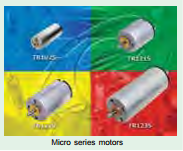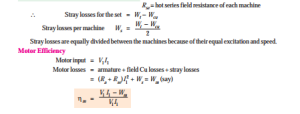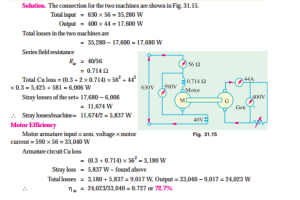Field’s Test for Series Motor
This test is applicable to two similar series motors. Series motors which are mainly used for traction work are easily available in pairs. The two machines are coupled mechanically.
One machine runs normally as a motor and drives generator whose output is wasted in a variable load R (Fig. 31.14). Iron and friction losses of two machines are made equal (i) by joining the series field winding of the generator in the motor armature circuit so that both
machines are equally excited and (ii) by running them at equal speed. Load resistance R is varied till the motor current reaches its full-load value indicated by ammeter A1. After this adjustment for full-load current, different ammeter and voltmeter readings are noted.
Let V = supply voltage ; I1 = motor current ; V2 = terminal
p.d. of generator ; I2 = load current.
Intake of the whole set = VI1 ; output = V2I2. Total losses in the set, Wt = VI1 – V2I2
Armature and field Cu losses Wcu = (Ra + 2Rse)I1 + I2 Ra
where Ra = hot armature resistance of each machine
Generator Efficiency
The generator efficiency will be of little use because it is running under abnormal conditions of separate
excitation. However, the efficiency under these unusual conditions can be found if desired.
It should be noted that although the two machines are mechanically coupled yet it is not a regenerative method, because the generator output is wasted instead of being fed back into the motor as in Hopkinson’s (back-to-back) test.
Example 31.20. A test on two coupled similar tramway motors, with their fields connected in series, gave the following results when one machine acted as a motor and the other as a generator. Motor : Armature current = 56 A ; Armature voltage = 590 V
Voltage drop across field winding = 40 V Generator :
Armature current = 44 A ; Armature voltage = 400 V
Field voltage drop = 40 V ; Resistance of each armature = 0.3 W
Calculate the efficiency of the motor and gearing at this load.
(Elect. Machinery-II, Nagpur Univ. 1992 & JNTU, Hyderabad, 2000)
Tutorial Problem No. 31.1
1. A 500-V, shunt motor takes a total current of 5 A when running unloaded. The resistance of armature circuit is 0.25 W and the field resistance is 125 W. Calculate the efficiency and output when the motor is loaded and taking a current of 100 A.
[90.4% ; 45.2 kW]
2. A d.c. shunt motor rated at 12.5 kW output runs at no-load at 1000 r.p.m. from a 250-V supply consuming an input current of 4 A. The armature resistance is 0.5 W and shunt field resistance is 250 W. Calculate the efficiency of the machine when delivering full-load output of 12.5 kW while operating at 250
V. [81.57%] (Elect. Technology-I Madras Univ. 1979)
3. The following results were obtained during Hopkinson’s test on two similar 230-V machines; armature currents 37 A and 30 A; field currents 0.85 A and 0.8 A. Calculate the efficiencies of machines if each has an armature resistance of 0.33 W.
[Generator 87.9%, Motor 87.7%]
4. In a Field’s test on two 230-V, 1.492 kW mechanically-coupled similar series motors, the following figures were obtained. Each has armature and compole winding resistance of 2.4 W, series field resistance of 1.45 W and total brush drop of 2 V. The p.d. across armature and field was 230 V with a motor current of 10.1 A. The generator supplied a current of 8.9 A at a terminal p.d. of 161 V. Calculate the efficiency and output of the motor for this load.
[76.45%, 1.775 kW]
5. Describe the Hopkinson’s test for obtaining the efficiency of two similar shunt motors. The readings obtained in such a test were as follows ; line voltage 100 V ; motor current 30 A ; generator current 25 A ; armature resistance of each machine 0.25 W. Calculate the efficiency of each machine from these results, ignoring the field currents and assuming that their iron and mechanical losses are the same.
[Motor 90.05%, Generator 92.5%]
6. The Hopkinson’s test on two similar d.c. shunt machines gave the following results :
Line voltage = 220 V ; line current excluding field currents = 40 A ; the armature current of motoring machine = 200 A ; field currents 6 A and 7 A. Calculate the efficiency of each of the machines at the given load conditions. The armature resistance of each of the machines is 0.05 W.
Related posts:
Incoming search terms:
- field test on dc series motor
- field test on dc series machine
- brake test on dc series motor
- field test on dc series machine theory
- field test of dc machine
- field test on dc series machines theory
- field test on DC series motor theory
- field test on dc series machines
- load test on dc series motor theory
- load test on dc series motor experiment
- load test on dc series motor
- Field test on series motor
- field test of dc motor
- field test on dc machine
- field test on dc series machine experiment
- fields test on dc series motor
- brake test of dc series motor
- field test for series motor
- field test on dc series motor experiment
- field test of dc series motor
- fields test on dc series machines
- testing of dc machines
- field test in dc machines
- brake test on dc series motor experiment
- field test theory
- field test for dc series motor
- field test on series motor theory
- theory of field test on dc series motor
- field test in dc motor
- field test on dc series machine lab manual
- theory of field test on dc series machine
- field test dc series motor
- field test on dc machines
- brake test in dc machines
- Describe Motor generator set testing diagram
- field test on dc motor
- theory of load test on dc series motor
- field test on two dc series machines
- field test on dc
- field test on dc shunt motor
- theory of field test on dc series machines
- field test on two identical series machines
- load test on dc series motor pdf
- field test on series motor means
- explain field test for dc series motor
- theory of brake test on dc series motor
- field test on series machine
- Series field test
- field test on dc series machine procedure
- field test dc motor





